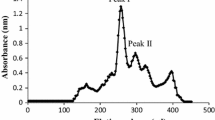Abstract
Egg and female hemolymph proteins were resolved via SDS-polyacrylamide gel electrophoresis in a diverse array of 33 endemic Hawaiian drosophilids, encompassing 17 picture-winged species, 3 of theantopocerus species group, 9 fungus feeders, 1 species from each of the modified mouthparts,crassifemur and ciliated tarsus groups, and 1Scaptomyza species. Molecular weights of the two (10 species) or three vitellogenin bands (22 species) were highly variable, spanning a 7-kD range. The largest vitellogenin, V1, was the most variable, showing a change of some 10% in its mean size of 47.6 kD. The smallest V3 vitellogenin, mean size 44.1 kD, was evolutionarily the most conservative in size. The speciesDrosophila hawaiiensis was found to be polymorphic for two/three vitellogenin bands and, also, polymorphic with respect to the size of the V1 protein. No inter- or intrapopulation variability in vitellogenin size was detected in 10 other species examined. The major features of vitellogenin protein evolution in the HawaiianDrosophila are change in molecular weight and regulatory differences that result in quantitative differences between species in patterns of vitellogenin protein production.
Similar content being viewed by others
References
Barnett, T., Pachl, C., Gergen, J. P., and Wensink, P. C. (1980). The isolation and characterization ofDrosophila yolk protein genes.Cell 21729.
Bownes, M. (1980). The use of yolk protein variations inDrosophila species to analyse the control of vitellogenesis.Differentiation 16109.
Bownes, M. (1982). Hormonal and genetic regulation of vitellogenesis in Drosophila.Q. Rev. Biol. 57247.
Bownes, M., and Hames, B. D. (1977). Accumulation and degradation of three major yolk proteins inDrosophila melanogaster.J. Exp. Zool. 200149.
Brennan, M. D., Weiner, A. J., Goralski, T., and Mahowald, A. P. (1982). The follicle cells are a major site of vitellogenin synthesis inDrosophila melanogaster.Dev. Biol. 89225.
Carson, H. L. (1981a). Homosequential species of HawaiianDrosophila.Chromosomes Today 7150.
Carson, H. L. (1981b). Chromosomal tracing of evolution in a phylad of species related toDrosophila hawaiiensis. In Atchley, W. R., and Woodruff, D. S. (eds.)Evolution and Speciation Cambridge University Press, Cambridge, pp. 286–297.
Carson, H. L., and Kaneshiro, K. Y. (1976).Drosophila of Hawaii: Systematics and ecological genetics.Annu. Rev. Ecol. Syst. 7311.
Carson, H. L., and Yoon, J. S. (1982). Genetics and evolution of HawaiianDrosophila. In Ashburner, M., Carson, H. L., and Thompson, J. N., Jr. (eds.)The Genetics and Biology of Drosophila, Vol. 3b Academic Press, New York, pp. 297–344.
Carson, H. L., Hardy, D. E., Spieth, H. T., and Stone, W. S. (1970). The evolutionary biology of the Hawaiian Drosophilidae. In Hecht, M. K., and Steere, W. C. (eds.)Essays in Evolution and Genetics in Honor of Theodosius Dobzhansky Appleton-Century-Crofts, New York, pp. 437–543.
Clague, D. A., and Dalrymple, G. B. (1987). In Decker, R. W., Wright, T. L., and Stauffer, P. H. (eds.),Volcanism in Hawaii U.S. Government Printing Office, Washington, D.C., pp. 5–54.
Craddock, E. M., and Kambysellis, M. P. (1978). Interspecific variability in the vitellogenin proteins of HawaiianDrosophila.Am. Zool. 18638.
Dong, K.-W. (1987).Genetic Variation and Evolution of the Vitellogenin Genes and Proteins Among Species of the planitibia Subgroup of Hawaiian Drosophila Ph.D. thesis, New York University, New York.
Garabedian, M. J., Shepherd, B. M., and Wensink, P. C. (1986). A tissue-specific transcription enhancer from the Drosophila yolk protein 1 gene.Cell 45859.
Garabedian, M. J., Shirras, A. D., Bownes, M., and Wensink, P. C. (1987). The nucleotide sequence of the gene coding forDrosophila melanogaster yolk protein 3.Gene 551.
Gelti-Douka, H., Gingeras, T. R., and Kambysellis, M. P. (1974). Yolk proteins inDrosophila: Identification and site of synthesis.J. Exp. Zool. 187167.
Hardy, D. E. (1965).Insects of Hawaii, Vol. 12. Diptera: Cyclorrhapha II, Series Schizophora, Section Acalypterae I. Family Drosophilidae University of Hawaii Press, Honolulu.
Hatzopoulos, P., and Kambysellis, M. P. (1987). Isolation and structural analysis ofDrosophila grimshawi vitellogenin genes.Mol. Gen. Genet. 206475.
Heed, W. B. (1968). Ecology of the Hawaiian Drosophilidae.Univ. Texas Publ. 6818387.
Hung, M.-C., and Wensink, P. C. (1981). The sequence of theDrosophila melanogaster gene for yolk protein 1.Nucl. Acids Res. 96407.
Hung, M.-C., and Wensink, P. C. (1983). Sequence and structure conservation in yolk proteins and their genes.J. Mol. Biol. 164481.
Kambysellis, M. P. (1978). A simple technique for collecting hemolymph from adultDrosophila.Dros. Info. Serv. 53218.
Kambysellis, M. P., and Heed, W. B. (1971). Studies of oogenesis in natural populations of Drosophilidae. I. Relation of ovarian development and ecological habitats of the Hawaiian species.Am. Nat. 10631.
Kambysellis, M. P., Hatzopoulos, P., Seo, E. W., and Craddock, E. M. (1986). Noncoordinate synthesis of the vitellogenin proteins in tissues ofDrosophila grimshawi.Devel. Genet. 781.
Kambysellis, M. P., Hatzopoulos, P., and Craddock, E. M. (1989). The temporal pattern of vitellogenin synthesis inDrosophila grimshawi.J. Exp. Zool. 251339.
Laemmli, U. K. (1970). Cleavage of structural proteins during assembly of the head of bacteriophage T4.Nature 227680.
Macdonald, G. A., and Abbott, A. T. (1970).Volcanoes in the Sea: The Geology of Hawaii University of Hawaii Press, Honolulu.
Mahowald, A. P., and Kambysellis, M. P. (1980). Oogenesis. In Ashburner, M., and Wright, T. E. (eds.)The Genetics and Biology of Drosophila, Vol. 2d Academic Press, London, pp. 141–224.
Mitsis, P. G., and Wensink, P. C. (1989). Identification of yolk protein factor 1, a sequence-specific DNA binding protein fromDrosophila melanogaster.J. Biol. Chem. 2645188.
Montgomery, S. L. (1975). Comparative breeding site ecology and the adaptive radiation of picture-wingedDrosophila.Proc. Haw. Entomol. Soc. 2265.
Spieth, H. T. (1966). Courtship behavior of endemic HawaiianDrosophila.Univ. Texas Publ. 6615245.
Throckmorton, L. H. (1966). The relationships of the endemic Hawaiian Drosophilidae.Univ. Texas Publ. 6615335.
Author information
Authors and Affiliations
Additional information
This research was supported by NSF Grants DEB-7619872 and PCM-7913074. This paper is No. III in the series “Studies of Oogenesis in Natural Populations of Drosophilidae.”
Rights and permissions
About this article
Cite this article
Craddock, E.M., Kambysellis, M.P. Vitellogenin protein diversity in the HawaiianDrosophila . Biochem Genet 28, 415–432 (1990). https://doi.org/10.1007/PL00020664
Received:
Revised:
Issue Date:
DOI: https://doi.org/10.1007/PL00020664




